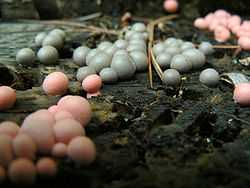Lycogala epidendrum
| Lycogala epidendrum | |
|---|---|
 | |
| Fruiting bodies of L. epidendrum | |
| Scientific classification | |
| Kingdom: | Amoebozoa |
| Phylum: | Mycetozoa |
| Class: | Myxogastria |
| Order: | Liceales |
| Family: | Tubiferaceae |
| Genus: | Lycogala |
| Species: | L. epidendrum |
| Binomial name | |
| Lycogala epidendrum (Linnaeus) Fries | |
Lycogala epidendrum, commonly known as wolf's milk, groening's slime is a cosmopolitan species of plasmodial slime mould which is often mistaken for a fungus. The aethalia, or fruiting bodies, occur either scattered or in groups on damp rotten wood, especially on large logs, from June to November. These aethalia are small, pink to brown cushion-like globs. They may excrete a pink paste if the outer wall is broken before maturity. When mature, the colour tends to become more brownish. When not fruiting, single celled individuals move about as very small, red amoeba-like organisms called plasmodia, masses of protoplasm that engulf bacteria, fungal and plant spores, protozoa, and particles of non-living organic matter through phagocytosis (see slime mould for more information).
Description

During the plasmodial stage, individuals are reddish in color, but these are almost never seen. When conditions change, the individuals aggregate by means of chemical signaling to form an aethalium, or fruiting body. These appear as small cushion-like blobs measuring about 3–15 millimetres (0.12–0.59 in) in diameter. Colour is quite variable, ranging from pinkish-grey to yellowish-brown or greenish-black, with mature individuals tending towards the darker end. They may be either round or somewhat compressed with a warted or rough texture. While immature they are filled with a pink, paste-like fluid. With maturity the fluid becomes a powdery mass of minute gray spores. The spores measure 6 to 7.5 µm and are round in shape with a netted texture and appearing ochre to lavender in colour. The pseudocapillitia, sterile elements in the spore mass, are long, flattened, branching tubes with transverse wrinkles and folds.[1]
Taxonomy
This species is classified in the family Tubiferaceae, [2] although it is accepted in the Reticulariaceae family by the Integrated Taxonomic Information System. [3]
See also
- Enteridium lycoperdon, the false puffball slime mould
References
- Notes
- ↑ Lincoff, Gary H. (1981). National Audubon Society Field Guide to North American Mushrooms. New York: Random House. p. 848. ISBN 0-394-51992-2.
- ↑ The Global Biodiversity Information Facility: GBIF Backbone Taxonomy, 2013-07-01. Accessed via http://www.gbif.org/species/3213352 on 2013-11-10
- ↑ Integrated Taxonomic Information System [Internet] 2013. [updated 2013 April; cited 2013 Nov 10] Available from: http://www.itis.gov/servlet/SingleRpt/SingleRpt?search_topic=TSN&search_value=181336
- Sources
- Stephenson, Steven L & Stempen, Henry (2000). Myxcomcetes. A Handbook of Slime Molds. Portland : Timber Press. ISBN 0-88192-439-3.
External links
| Wikimedia Commons has media related to Lycogala epidendrum. |
- "Photos of Lycogala epidendrum". Sociedad Micólogica de Madrid. 2006-10-17.